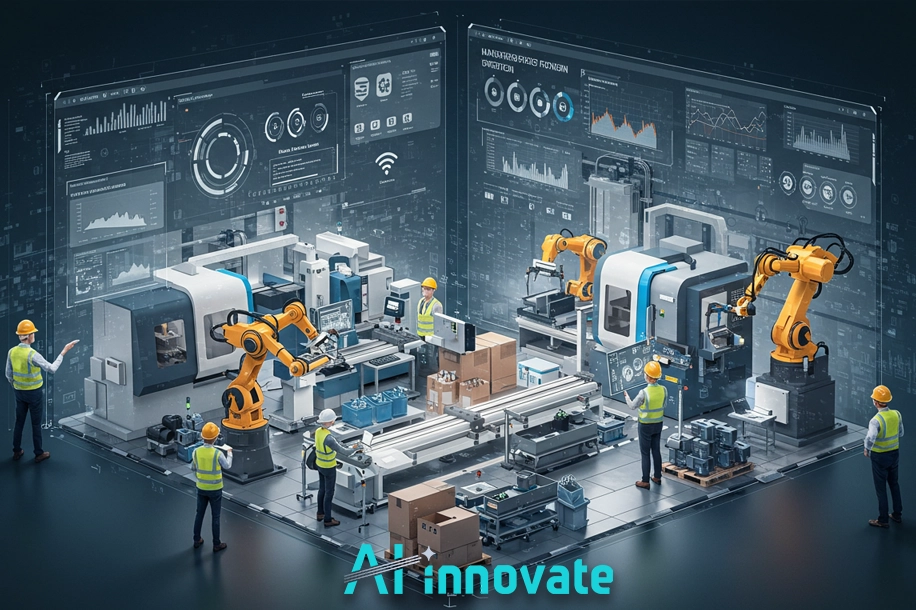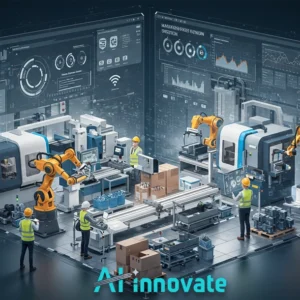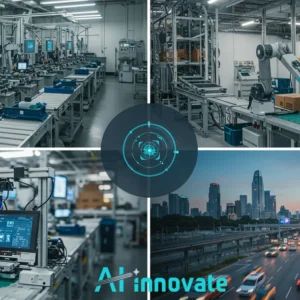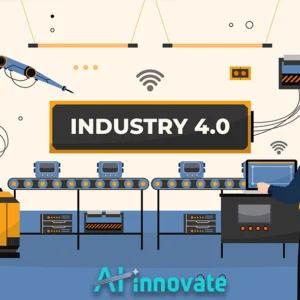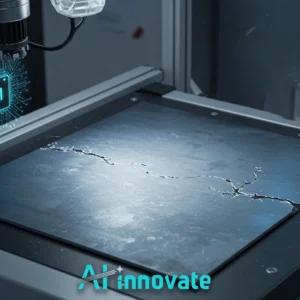Facing escalating global complexities and intense competition, manufacturing industries critically need robust and adaptable Business Process Optimization Tools. Achieving peak operational performance and ensuring absolutely uncompromised product quality consistency are no longer optional objectives for long-term success. AI-Innovate develops sophisticated AI and machine vision software uniquely designed to tackle these critical challenges head-on within specialized industrial sectors.
This article explores how the strategic deployment of Machine Learning techniques specifically within quality control stands as a particularly potent method for significant operational enhancement and holistic process optimization goals.
Your Smart Factory Starts Here
Integrate intelligent tools for end-to-end efficiency.
Industrial Operations Imperative
The contemporary industrial landscape is characterized by demands for higher throughput, customized products, compressed lead times, and unyielding quality standards, all against a backdrop of escalating operational costs.
Organizations operate under intense pressure to eliminate waste, improve resource utilization, and enhance overall agility. Relying on outdated or inefficient processes leads to significant competitive disadvantages, manifested in delayed deliveries, suboptimal resource allocation, and inconsistent product quality.
Strategic initiatives aimed at revitalizing these core processes through systematic analysis, redesign, and implementation are thus paramount. Achieving best-in-class operational performance requires a continuous focus on efficiency, accuracy, and adaptability, compelling manufacturers to explore innovative methodologies and enabling technologies that can deliver measurable improvements across their value chains.
Quality Control Friction Points
Traditional approaches to quality control, often heavily reliant on manual visual inspection or basic automated systems, are replete with inherent inefficiencies and limitations. These methods represent critical “friction points” within the production workflow, hindering broader business process optimization tools objectives.
- Cost and Human Error: Manual inspection is labor-intensive and prone to subjective judgment, fatigue-induced errors, particularly during repetitive tasks or the examination of high-speed lines.
- Speed and Coverage Deficits: Manual checks struggle to keep pace with modern high-speed manufacturing lines, making 100% inspection practically impossible and necessitating inefficient sampling techniques that risk letting defects pass.
- Lack of Consistency and Data: Human inspection introduces variability. Furthermore, manual processes generate limited quantitative data on the nature, frequency, and distribution of defects, inhibiting root cause analysis and proactive process adjustments.
- Difficulty with Subtle or Complex Defects: Identifying microscopic or intricate flaws on diverse material surfaces poses significant challenges for human inspectors and rule-based automated systems alike.
- Excessive Waste and Rework: Defects detected late in the process result in costly scrap, rework, and potential recalls, directly impacting profitability and sustainability goals.
These limitations underscore the need for more robust, objective, and scalable quality control mechanisms that can truly contribute to process optimization.
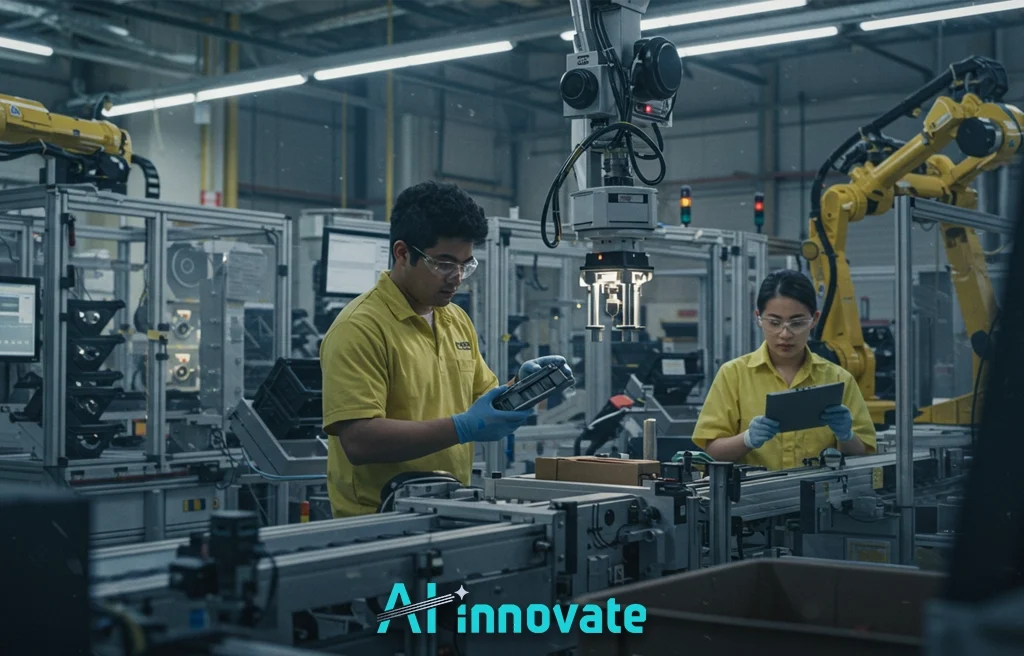
AI-Driven Precision Leap
The advent of Artificial Intelligence and Machine Learning introduces a fundamental paradigm shift in quality control, moving beyond reactive detection towards proactive prediction and real-time optimization.
This represents an AI-driven “precision leap,” transforming quality inspection from a bottleneck into an intelligent component of the production line. Unlike traditional methods limited by explicit programming and static thresholds, ML models learn directly from vast datasets of both acceptable and defective products.
This enables systems to identify nuanced patterns and anomalies that escape human observation or rigid rule sets. The outcome is not just faster inspection, but significantly higher accuracy and consistency.
Furthermore, AI facilitates moving towards 100% in-line inspection, ensuring every single product meets quality standards before it leaves the factory floor. This transition leverages machine learning in quality control to unlock previously unattainable levels of detail, speed, and predictive capability.
The Algorithmic Eye
At the heart of this transformation in quality inspection lies advanced machine vision for defect detection. The “algorithmic eye” leverages sophisticated camera systems and computer vision techniques powered by deep learning models to ‘see’ and interpret images of products on the line.
- Data Acquisition: High-resolution cameras capture images or video streams of products, often under controlled lighting conditions to highlight specific features or potential defects.
- Learning from Data: ML models, particularly Convolutional Neural Networks (CNNs), are trained on massive, annotated datasets containing examples of various defects and flawless items. Through iterative training, the model learns to distinguish minute variations and patterns associated with different types of flaws.
- Pattern Recognition and Detection: Once trained, the model can rapidly analyze new images, comparing them against the learned patterns to identify and classify defects in real-time defect analysis. This includes challenging tasks such as identifying defect detection in manufacturing processes on various surfaces like textiles, metals, or plastics, capturing imperfections often missed by human inspectors due to scale, speed, or complexity.
This data-driven learning capability allows the system to adapt and improve over time as it encounters new variations, establishing a foundation for highly accurate and reliable automated inspection.
Measurable Impact Realized
Implementing ML-powered quality control delivers quantifiable benefits that directly contribute to wider organizational business process optimization tools objectives. The impact extends beyond mere defect identification to influence key operational metrics. Let us examine some of the tangible outcomes reported across various industrial sectors:
- Reduced Waste and Rework: Early and accurate defect detection prevents faulty products from progressing further down the line, significantly reducing scrap material and the costs associated with rework.
- Increased Throughput and Efficiency: Automated, high-speed inspection allows production lines to operate at optimal speeds without being limited by manual checks, boosting overall operational capacity.
- Enhanced Quality Consistency: AI systems provide objective, repeatable inspection, minimizing variability caused by human factors and ensuring a higher, more consistent standard of product quality output.
- Lower Operational Costs: Automation reduces reliance on extensive manual labor for inspection tasks and mitigates the substantial financial penalties associated with undetected defects, returns, and warranty claims.
- Data-Driven Insights: Automated systems generate rich datasets on defect types, locations, and frequencies, enabling granular analysis for proactive process improvements upstream in the production flow.
These realized impacts translate directly into improved profitability, enhanced competitiveness, and stronger customer satisfaction – clear markers of effective process optimization.
Tools for Transformation
Effectively achieving the quantifiable benefits of integrating Machine Learning into quality control necessitates the deployment of purpose-built software and hardware. These specialized applications represent the practical business process optimization tools that enable industries to transition from conceptual potential to tangible operational improvement.
Addressing the distinct needs of both strategic leaders focused on production outcomes and technical teams responsible for developing and implementing vision solutions is key to this transition.
The market offers robust technologies designed to bridge the gap between AI capabilities and factory floor realities, providing concrete pathways for optimization.
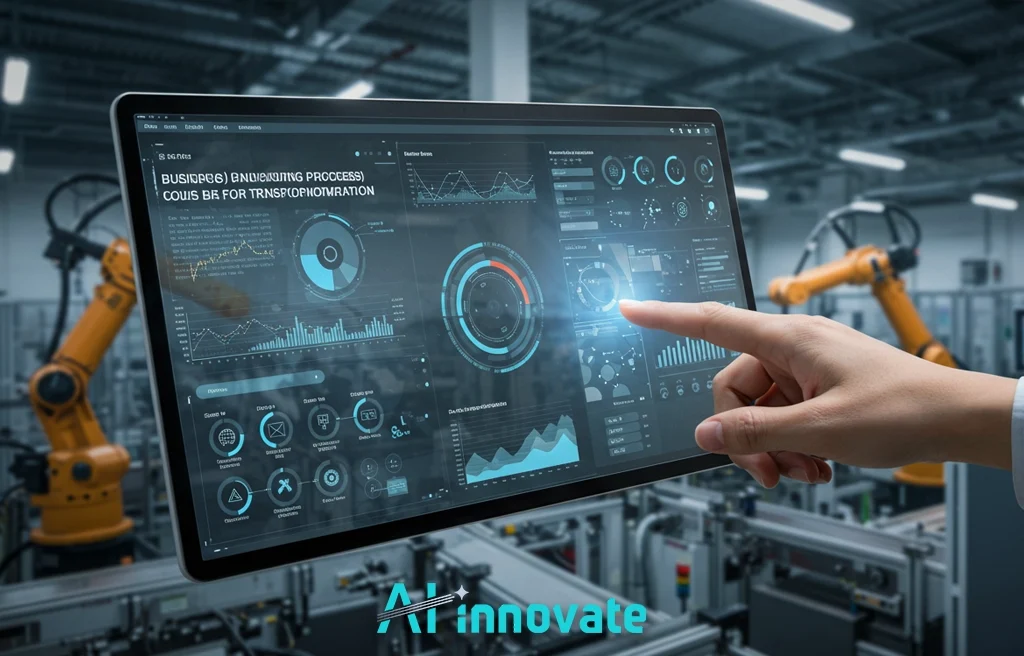
AI2Eye: Revolutionizing Manufacturing Quality Control
For manufacturers aiming to elevate their real-time inspection capabilities directly on the production line, sophisticated systems powered by AI and machine vision are indispensable. AI2Eye exemplifies such a solution, functioning as an advanced system engineered for live, in-line product quality verification.
It directly addresses the production imperative by providing accurate defect detection in manufacturing processes. Its core capabilities extend beyond mere identification to actively inform process adjustments.
Key outcomes for operators and QA managers include a substantial reduction in material waste by catching flaws early, a notable boost in operational efficiency through automated and rapid analysis, and a guaranteed higher standard of consistent quality output across every production cycle, fundamentally enhancing AI-driven quality control.
AI2Cam: A Virtual Camera for Machine Vision Development
Concurrently, the innovation driving these powerful industrial applications relies on efficient development tools. Machine learning engineers and researchers require flexible platforms that accelerate the prototyping and testing phases of machine vision projects without the dependencies and costs associated with physical industrial cameras.
AI2Cam serves precisely this need as a software-based “virtual camera” or emulator. By accurately simulating various camera models and imaging conditions, it provides a development environment that enables significantly faster prototyping timelines.
This leads to considerable cost reduction by mitigating hardware investments, offers increased flexibility for exploring diverse scenarios, and facilitates seamless remote collaboration among development teams, proving invaluable for technical specialists in this domain.
Leading the AI Integration Journey
Empowering manufacturing operations and accelerating the development of vision systems requires partner expertise. Organizations seeking to harness these transformative capabilities for process optimization can turn to leaders in applied AI solutions.
Dedicated to solving real-world industrial challenges through intelligent, practical tools, AI-Innovate provides the foundational software—AI2Eye and AI2Cam—that enables factories to deploy sophisticated quality control systems and empowers technical teams to innovate with agility.
For those ready to explore how AI-Innovate’s specialized solutions can drive efficiency and enhance quality within their specific industrial context, discovering their full range of offerings marks a logical next step in the journey toward intelligent manufacturing.
Navigating Adoption Pathways
Integrating Machine Learning into quality control workflows for enhanced business process optimization Tools requires a thoughtful strategic approach to implementation. Manufacturers must navigate challenges such as ensuring sufficient high-quality data for model training and securing the requisite specialized technical expertise.
Integrating sophisticated new systems seamlessly with existing legacy factory automation platforms, including SCADA or MES, presents distinct technical hurdles requiring careful planning. Additionally, successful deployment mandates proactive organizational change management to secure team buy-in and facilitate smooth transitions.
Overcoming these complexities involves initiating with well-defined pilot projects, engaging in meticulous planning for scalable deployment phases, investing significantly in comprehensive workforce training, and fostering robust cross-functional collaboration across engineering, IT, and operations departments to pave a clearer path toward widespread adoption of these transformative capabilities within production environments.
Conclusion
Manufacturing success requires sharp operational focus. Potent business process optimization tools are indispensable. Machine Learning, applied strategically in quality control, is a key BPO driver. This data-driven AI for quality assurance achieves unparalleled precision and speed, delivering tangible benefits like reduced waste and higher product quality. Implementing such transformative solutions with specialized tools is critical for competitive leadership in the industrial age.

